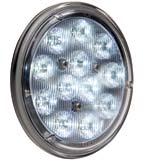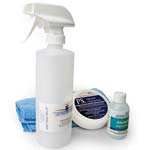Pilot Products: Odds and Ends
Sporty's new flight bag, LED landing light, and aircraft cleaner
Flight bag designs have exploded in recent years to the point that it’s hard to remember that pilots used to carry everything in a briefcase or other improvised sacks. And while flight bags may fit under the nice-to-have category, new market offerings are making them hard to resist.
Sporty’s Flight Gear Mission Bag

Who: Sporty’s Flight Gear Mission Bag
What: Mid-size vertically oriented flight bag
Where: www.sportys.com
Why: Because every pilot deserves a great flight bag
Cost: $62.95
Pros:
- Built to last
- Thoughtfully and logically designed
- Numerous pockets for good organization
Cons:
- Maybe not as many pockets as some users would want
- No color choices
- Some users may find the main storage area tight on space
Sporty’s new Flight Gear Mission Bag is sure to make you want to part with some of your hard-earned cash. It’s Sporty’s answer to the wildly successful Brightline Bags flight bag introduced a few years ago. The shape, function, and features are a clear indication that the folks at Sporty’s felt the need to answer the challenge Brightline posed.
The bag measures 10 inches wide by eight inches deep by 13 inches tall. It has lots of pockets, but considerably fewer than Brightline. If you are in the “more is better” camp, you may feel it doesn’t have enough dedicated pockets. But for most users, the number of pockets will be a nice fit. There’s one large main compartment that can be accessed from the side or the top, which is great in the cockpit. A few outside pockets, an inside mesh pocket, and a few perfectly sized pen and fuel-sampler pockets—and you have pretty much everything you need. And if you want more space, the bag fits into Sporty’s MyBag program, a series of accessories that can be clipped to the outside of the bag.
The Mission Bag, like others in the Flight Gear collection, is extremely sturdy, very well constructed, and features robust zippers. But perhaps the best design element of the Mission Bag is the shoulder strap. It may seem odd to place emphasis on something so minor, but flight bag shoulder straps are a constant annoyance. They are often thin, not padded, and hang centered on the bag—which means they often fall off your shoulder when you walk. But the Mission Bag’s shoulder strap is curved so that the bag sits flat against your hip while you walk, as it should. Minor? Yes. A good sign of the bag’s attention to detail? Absolutely.
Whelen Parmetheus LED landing/taxi lights
Long-lasting light-emitting diodes (LEDs) are making further inroads to replacing all incandescent lighting on general aviation airplanes. Today, with advancing technology in LEDs and shrinking requirements for heat sinks, LED landing and taxi lights are now available as drop-in replacements for traditional incandescent bulbs. LEDs provide many thousands of hours of operation—even in high-vibration environments.
Whelen LED landing and taxi light

Who: Whelen Engineering Parmetheus
What: LED landing and taxi light
Where: www.whelen.com
Why: LEDs are cheaper over time, and they are much brighter
Cost: $239
Pros:
- Broader beam and better reach than incandescent
- Longer lasting and more reliable than incandescent
Cons:
- High up-front cost
- Some aircraft applications may require a Form 337
Whelen Engineering recently STCed and PMAed its Parmetheus Series Super-LED Lighting products, which are available for most GA aircraft that use PAR 36-size bulbs. Parmetheus LEDs are available with a standard lens for landing lights or a fluted lens for a broader taxi light beam.
I installed two Parmetheus bulbs in the cowling of my family’s Cessna 172, which typically chewed through incandescent bulbs at a prodigious rate. Installation is “drop-in” simple as advertised.
After the switch to the Parmetheus bulbs, I was welcomed to a brighter and broader taxi-light beam, as well as a brighter landing light with longer “reach.” Concurrently, I no longer hear the whine of an overworked alternator filling my headset. In fact, when turning on the lights the 172’s ammeter needle doesn’t budge. The digital ammeter installed on the airplane’s systems monitor showed a 1-amp increase when turning on each bulb.
The light hue is bluish (6500K color temperature) compared to the yellow illumination that came from the incandescent bulbs, which appears to better illuminate grassy areas. The best part is I can now run both lights continuously for better conspicuity, with much less worry that the lights will not be available for my next night landing.
Parmetheus bulbs run about $239 each, a tidy sum for sure. But with incandescent replacements selling for $20 or so and lasting as little as 25 hours in high-vibration areas, payback will come in about 300 hours. The bulbs are warranted for three years. A list of airframes available for LED replacements and other information can be found at www.whelen.com. —Peter A. Bedell
JetShineUSA Permanon
It took a while to understand this product and how to use it, but after testing it the bottom line was this: It works. Permanon is a German-made surface-protection product distributed in this country by JetShineUSA.
Jet Shine Aircraft cleaner and surface protectant

Who: Jet Shine USA Permanon
What: Aircraft cleaner and surface protectant
Where: www.jetshineusa.com; www.permanon.com
Why: Who wants to clean the aircraft belly often?
Cost: $34.51 for the starter kit
Pros:
- Wonderful as a cleaner
- Even better at preventing future grime build up
Cons:
- Pricey
- A little tricky to apply
JetShineUSA officials promised that use of Permanon, in conjunction with a concentrated super-soap made by Permanon called PS Paste, could remove any stain. Once clean, you spray the surface with Permanon to protect it, and future stains disappear with a mild household cleaner.
It was fussy to use. Instructions indicated that the PS Paste should be used in small, hard-to-clean areas. But the soap itself may require Windex or some similar cleaner to remove all the residue.
First, I tried swiping through the oil and exhaust stains on the belly of a Cessna 172 after first spraying a swath of Windex across the dirty area. After trying four times to remove grease and grime with Windex, I then moistened a tiny sponge provided in the Starter Kit, loaded it with PS Paste, and applied it to the area. The company had advised me to leave it on the aircraft for a while, so I went inside the flight school office to mix some Permanon. That consisted of pouring a small bottle of Permanon concentrate into a 16-ounce plastic spray bottle provided in the kit, and filling the bottle with water.
I had also been advised to remove the soap, once it has done its job, with Windex. After cleaning off the soap the grunge was gone, and the surface was clean. I then sprayed Permanon, spread it around with a microfiber cloth, and dried the area. The airplane left on a rental flight, thankfully to come back dirty. I had been told that a swipe with a towel loaded with Windex would clean off any new grime, so I sprayed and wiped the cleaned area. The towel showed oil and soot, and the area was once again clean. When I tried to clean areas a few inches away that had not been treated with Permanon, the Windex-loaded cloth merely smeared the grime. —Alton K. Marsh


